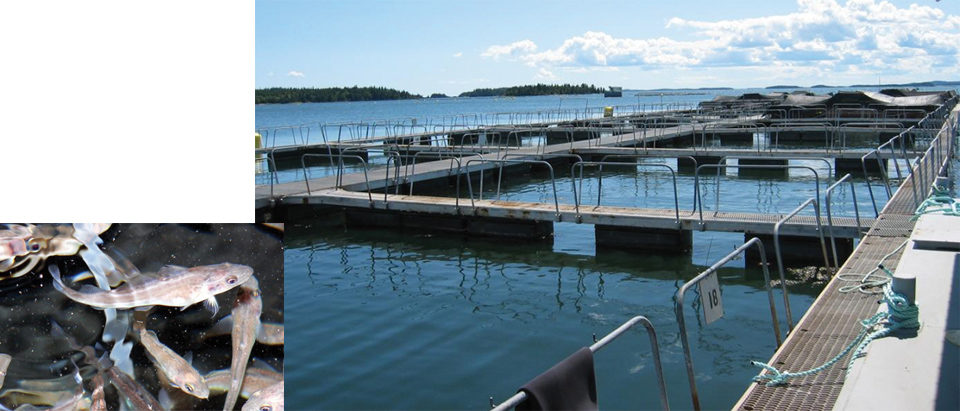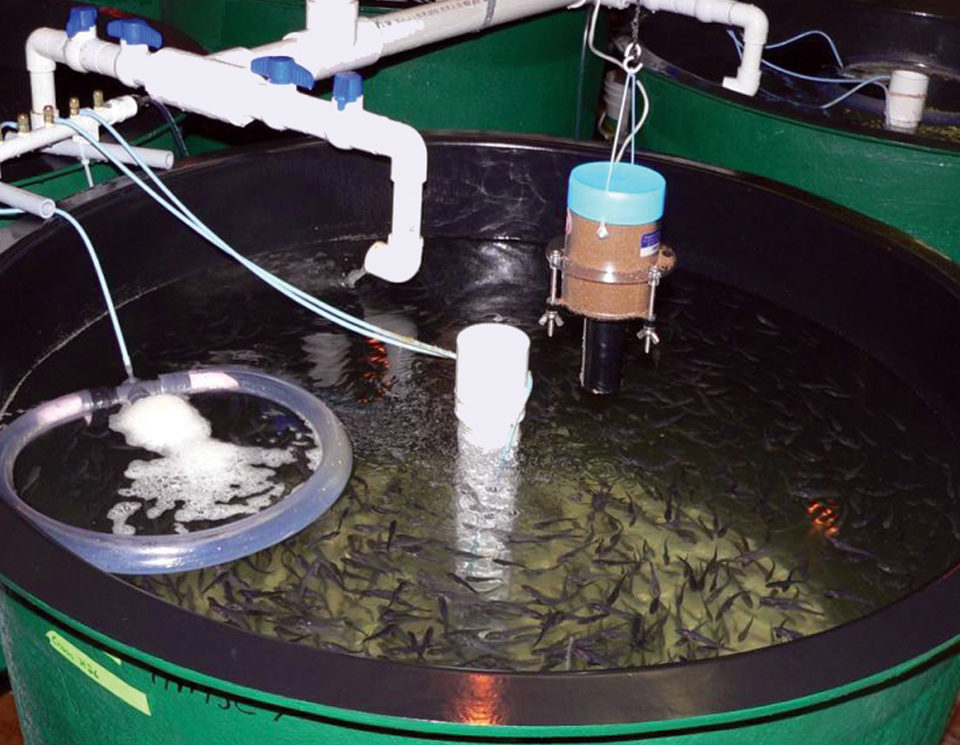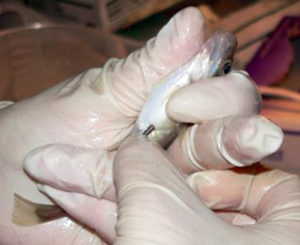Advancing selective breeding in Canada

Declining wild populations of Atlantic cod worldwide have resulted in renewed interest in farming this species, with cod aquaculture increasingly important in Atlantic Canada. While most of the basic cod culture protocols have been developed, continued reliance on unselected wild stocks is limiting the progress of this developing industry.
To help advance the domestication of this species, the CAD $18.1 million Atlantic Cod Genomics and Broodstock Development Project (CGP) was established to develop cod family-based selective-breeding programs in Newfoundland and Labrador, and New Brunswick, Canada, and New Hampshire, USA. In parallel, a large-scale genomics initiative is also under way.
The Atlantic Cod Genomics and Broodstock Development Project is a unique four-year initiative that brings together key participants from industry, universities, government, and not-for-profit organizations in a partnership on cod aquaculture. The CGP is managed by Genome Atlantic with funding provided by Genome Canada, the Atlantic Canadian Opportunities Agency, Fisheries and Oceans Canada, provincial funding bodies in the Atlantic provinces, industrial partners, and participating institutions.
Gene data expanded
A major factor limiting the directed improvement of cod broodstock is the scarcity of molecular tools. Only 2,278 sequences were available in the GenBank database of nucleotide sequences for this species before initiation of this project. The CGP has already dramatically increased the cod genomic resources available in public databases and contributed over 94 percent of the (Gadus morhua) sequences in GenBank.
These sequences are being used for comparative genomics and to identify polymorphisms in Canadian broodstock, develop gene-linked markers for use in broodstock management, and generate tools for expression analysis. The resources will be invaluable for analyzing quantitative trait loci, identifying important genes in Canadian cod aquaculture, and enabling marker-assisted selection within the associated breeding program. Molecular tools developed within this program can also be applied in the study of captive and wild cod populations globally.
Related issues
Researchers are also working closely with CGP scientists and industry partners to consider ethical, environmental, economic, legal, and social issues related to CGP research results. They are examining ethical questions related to benefit sharing among the research and commercialization partners, and other questions regarding the status of elite Atlantic cod broodstock under Canadian environmental law.
Breeding program design
The two separate regional cod broodstock development programs were initiated in 2005 utilizing local wild cod stocks to establish families for the future benefit of the provincial aquaculture industries. To compare individual rearing with communal rearing as a strategy for family-based selective breeding, the program includes families pooled during the early stages of rearing (Group 2) or combined after tagging at a minimum average weight of approximately 15 g (Group 1).
The measurement and genetic evaluation of economically valuable traits such as growth, sexual maturation, fish health, thermal and hypoxia tolerance, survival, product quality, and yield will be conducted on the families. The benefits of incorporating specific traits into the breeding program design will also be assessed, with the target of producing fast-growing, high-quality, and healthy cod.
Establishing cod families

The first step in the CGP project was to collect wild broodstock from multiple locations in Atlantic Canada and one site in the United States. Broodstock previously generated from stocks housed at the Ocean Sciences Centre, Newfoundland and Labrador (N.L.), Canada, were also used as parents. Ambient spawning stocks were used in New Brunwick (N.B.) and New Hampshire (N.H.), whereas manipulated broodstock exposed to four months of advanced photoperiod became parents in N.L.
Prior to spawning, genotypes were obtained for five or six microsatellite DNA loci to estimate relatedness, and only unrelated individuals were crossed during spawning. The broodstock were artificially strip spawned or pair mated to establish full- and half-sibling families using the Berg and Henryon breeding design, where each sire is mated to two dams, and each dam is mated to two sires. Research on the use of hormone implants prior to and during spawning to better synchronize spawning and reduce age differences between the families was also conducted.
Since the onset of the project, a total of 436 individual family crosses have been created, and 226 families from three year classes are currently being evaluated. Cod-rearing expertise and protocols developed previously by project participants were adapted where necessary to successfully rear the cod families.
Early progress
During the first major spawning season of December 2005 to April 2006, the CGP produced 103 full- and half-sibling families for communal rearing in sea cages. Initial measurements on all Group 1 families were collected 90 days post-hatch for 36 N.L. families and 105 days post-hatch for 38 N.B. and 11 N.H. families, with mean body weights ranging 0.18 to 0.72, 0.75 to 2.67 and 1.01 to 3.11 grams, respectively (P < 0.0001). In N.L., 1,782 individual length and weight measurements indicated the correlation between length and weight was 0.89 (P < 0.0001).
Data were also collected on juvenile cod at tagging on 22 families from N.L., 38 families from N.B., and 10 families from N.H. During tagging, the data recorded included body weight, total length, and the presence and types of deformities. Only nondeformed healthy individuals were tagged. Given the age differences between the families, individual fish weights and length were preadjusted for age based on days after fertilization with degree days as a covariate.
This analysis revealed high heritabilities for both traits. It indicated that additive genetic variation for body weight exists in North American cod broodstock populations, and this trait should respond well to selection. These results demonstrated the possibility for improvement of important commercial production traits in the developing cod aquaculture industry.
Sea cage evaluation

During the summer of 2006, the first major transfer of cod families to commercial sea cage sites took place. About 41,500 individuals from Group 2 families were transferred to a single commercial cage in July and August at a mean weight of about 8 grams. In November 2006, approximately 5,000 individuals of the Group 1 families tagged with passive integrated transponders were transferred to each of two commercial sea cage sites in New Brunswick. Some 3,000 individuals went to a site off the south coast of Newfoundland for further rearing and evaluation.
The Group 1 families will be reared for approximately 12 months in the cages before the first assessments of body weight, deformities, sex, and stage of sexual maturation. The final harvest assessment of the Group 1 and Group 2 families, and subsequent genetic evaluation and elite broodstock selection, will take place after approximately 24 months in the cages, assuming a three-year generation cycle.
Family identification of the Group 2 families will be determined post-harvest by microsatellite DNA analysis. In addition to the sea cage performance trials, families are also undergoing laboratory-based stress response, thermal tolerance, and disease challenge tests to determine the variability in these traits and assess their potential for future incorporation into a marker-assisted selection program.
As the families from the previous spawning seasons continue to be reared and evaluated in the sea cages, an additional year class of families (232 crosses total) was generated in N.L. and N.B./N.H. from December 2006 to February. Survival has been good to date and evaluation is ongoing.
Outlook
Ultimately, the data collected on all families at all sites will be combined for analysis and genetic evaluation. The trait data collected will be used for estimating genetic heritabilities and genetic and phenotypic correlations, and developing genetic evaluation procedures.
The family broodstock will be ranked according to the results of the genetic evaluation. The elite individuals will be selected as parents of the next generation of families and for the production of juveniles for commercial culture by the CGP’s industry partners in 2009.
(Editor’s Note: This article was originally published in the July/August 2007 print edition of the Global Aquaculture Advocate.)
Now that you've finished reading the article ...
… we hope you’ll consider supporting our mission to document the evolution of the global aquaculture industry and share our vast network of contributors’ expansive knowledge every week.
By becoming a Global Seafood Alliance member, you’re ensuring that all of the pre-competitive work we do through member benefits, resources and events can continue. Individual membership costs just $50 a year. GSA individual and corporate members receive complimentary access to a series of GOAL virtual events beginning in April. Join now.
Not a GSA member? Join us.
Authors
-
Dr. Jane Symonds
NIWA Bream Bay Aquaculture Park
Ruakaka, New Zealand -
Dr. Amber Garber
Huntsman Marine Science Centre
St. Andrews, New Brunswick, Canada[97,99,46,101,110,105,114,97,109,110,97,109,115,116,110,117,104,64,114,101,98,114,97,103,97]
-
Dr. Sharen Bowman
The Atlantic Genome Centre
Halifax, Nova Scotia, Canada -
Danny Boyce, M.S.
Ocean Sciences Centre
Memorial University of Newfoundland
St. John’s, Newfoundland and Labrador, Canada -
Dr. Kurt Gamperl
Ocean Sciences Centre
Memorial University of Newfoundland
St. John’s, Newfoundland and Labrador, Canada -
Dr. V. Puvanendran
Ocean Sciences Centre
Memorial University of Newfoundland
St. John’s, Newfoundland and Labrador, Canada -
Dr. Matt Rise
Ocean Sciences Centre
Memorial University of Newfoundland
St. John’s, Newfoundland and Labrador, Canada -
Dr. Marlies Rise
Ocean Sciences Centre
Memorial University of Newfoundland
St. John’s, Newfoundland and Labrador, Canada -
Steve Neil, M.S.
Fisheries and Oceans Canada
Biological Station
St. Andrews, New Brunswick, Canada -
Dr. Ed Trippel
Fisheries and Oceans Canada
Biological Station
St. Andrews, New Brunswick, Canada -
Dr. Andy Robinson
Centre for Genetic Improvement of Livestock
University of Guelph
Guelph, Ontario, Canada -
Dr. Jane Tosh
Centre for Genetic Improvement of Livestock
University of Guelph
Guelph, Ontario, Canada -
Lynn Lush, M.S.
Fisheries and Oceans Canada
Northwest Atlantic Fisheries Centre
St. John’s, Newfoundland and Labrador, Canada -
George Nardi, M.S.
GreatBay Aquaculture, LLC
Portsmouth, New Hampshire, USA -
Frank Powell, M.S.
Cooke Aquaculture Inc.
Black’s Harbour, New Brunswick, Canada -
Jonathan Moir, M.S.
Northern Cod Ventures Ltd.
St. John’s, Newfoundland and Labrador, Canada -
Andy Walsh
Northern Cod Ventures Ltd.
St. John’s, Newfoundland and Labrador, Canada -
Prof. Keith Culver
University of New Brunswick
Fredricktown, New Brunswick, Canada -
Dr. Luis Afonso
The Institute for Marine Biosciences
Halifax, Nova Scotia, Canada -
Dr. Stewart Johnson
The Institute for Marine Biosciences
Halifax, Nova Scotia, Canada
Tagged With
Related Posts

Innovation & Investment
20 years of the Global Aquaculture Alliance
A timeline of key milestones and achievements by the Global Aquaculture Alliance and its third-party aquaculture certification scheme, Best Aquaculture Practices (BAP).

Responsibility
Advancing the ecosystem services of aquaculture
The Nature Conservancy was inactive in aquaculture until new program leader Robert Jones joined. His focus is on the positive outcomes of responsible aquaculture.

Aquafeeds
Amino acid requirements in developing marine fish
Most marine fish have pelagic eggs with large pools of free amino acids of fairly constant proportion regardless of species. The amino acids provide energy for metabolism and are an important nutritional asset for growing embryos.

Aquafeeds
Aquaculture Exchange: Andrew Jackson, IFFO
Aquaculture remains dependent on fishmeal and fish oil, crucial marine ingredients in aquafeeds, particularly at key life stages. Andrew Jackson, technical director at IFFO and one of the world’s foremost fishmeal experts, tells the Advocate that the two industries can coexist well into the future if properly managed.


